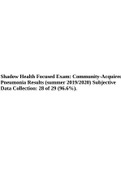Summary
Summary NR222 / NR 222 Final Exam Blueprint (Latest 2022 / 2023): Health & Wellness - Chamberlain
NR222 / NR 222 Final Exam Blueprint (Latest 2022 / 2023): Health & Wellness - Chamberlain
[Show more]
Uploaded on
January 26, 2022
Number of pages
5
Written in
2022/2023
Type
Summary
Course
NR222 / NR 222 Final Exam Blueprint : Health & Wellness - Chamberlain
All documents for this subject (2)
$16.49
Also available in package deal from $40.99
100% satisfaction guarantee
Immediately available after payment
Both online and in PDF
No strings attached
Also available in package deal (1)
NR222 / NR 222 Exam Study BUNDLE All EXAMS (Latest 2022 / 2023): Health & Wellness - Chamberlain College
$ 205.97
$ 40.99
13 items
1. Summary - Nr222 / nr 222: health & wellness exam 1 study guide (latest, 2021/2022) chamberlain...
2. Exam (elaborations) - Nr222 / nr 222 final exam (latest 2021 / 2022): health & wellness - chamberlain colle...
3. Summary - Nr222 / nr 222 final exam blueprint (latest 2021 / 2022): health & wellness - chamber...
4. Summary - Nr222 / nr 222 exam 2 study guide (latest 2021 / 2022): health & wellness - chamberl...
5. Summary - Nr222 / nr 222 exam 1 study guide (latest 2022 / 2023): health & wellness - chamberla...
6. Summary - Nr222 / nr 222 exam 1 (latest 2022 / 2023): health & wellness - chamberlain
7. Exam (elaborations) - Nr222 / nr 222 exam 1 (latest 2022/ 2023): health & wellness - chamberlain college
8. Summary - Nr 222 final exam study guide / nr222 final exam study guide (2022/2023): health and ...
9. Summary - Nr222 / nr 222 exam 3 review (latest 2022 / 2023): health & wellness - chamberlain
10. Summary - Nr222 / nr 222 final exam study guide all chapters (latest 2022 / 2023): health & wel...
11. Summary - Nr222 / nr 222 units 3,4, & 5 concept review (latest 2022 / 2023): health & wellness ...
12. Summary - Nr222 / nr 222 units 1 &2 concept review (latest 2022 / 2023): health & wellness - ch...
13. Summary - Nr222 / nr 222 final exam blueprint (latest 2022 / 2023): health & wellness - chamber...
Show more
NR 222 Final Exam Blueprint



